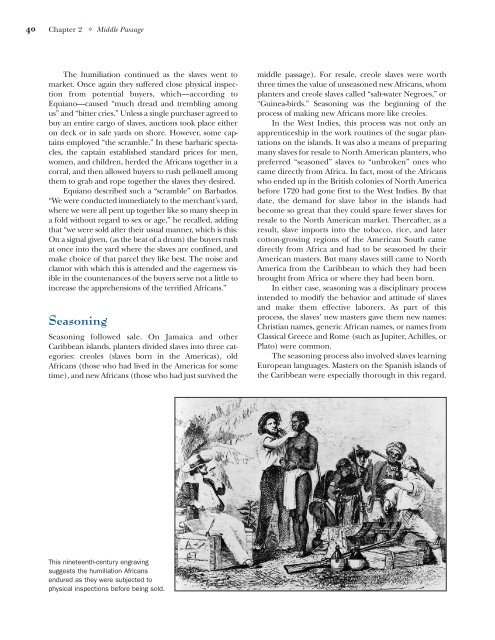Create successful ePaper yourself
Turn your PDF publications into a flip-book with our unique Google optimized e-Paper software.
40 Chapter 2 <strong>Middle</strong> <strong>Passage</strong><br />
The humiliation continued as the slaves went to<br />
market. Once again they suffered close physical inspection<br />
from potential buyers, which—according to<br />
Equiano—caused “much dread and trembling among<br />
us” and “bitter cries.” Unless a single purchaser agreed to<br />
buy an entire cargo of slaves, auctions took place either<br />
on deck or in sale yards on shore. However, some captains<br />
employed “the scramble.” In these barbaric spectacles,<br />
the captain established standard prices for men,<br />
women, and children, herded the Africans together in a<br />
corral, and then allowed buyers to rush pell-mell among<br />
them to grab and rope together the slaves they desired.<br />
Equiano described such a “scramble” on Barbados.<br />
“We were conducted immediately to the merchant’s yard,<br />
where we were all pent up together like so many sheep in<br />
a fold without regard to sex or age,” he recalled, adding<br />
that “we were sold after their usual manner, which is this:<br />
On a signal given, (as the beat of a drum) the buyers rush<br />
at once into the yard where the slaves are confined, and<br />
make choice of that parcel they like best. The noise and<br />
clamor with which this is attended and the eagerness visible<br />
in the countenances of the buyers serve not a little to<br />
increase the apprehensions of the terrified Africans.”<br />
Seasoning<br />
Seasoning followed sale. On Jamaica and other<br />
Caribbean islands, planters divided slaves into three categories:<br />
creoles (slaves born in the Americas), old<br />
Africans (those who had lived in the Americas for some<br />
time), and new Africans (those who had just survived the<br />
This nineteenth-century engraving<br />
suggests the humiliation Africans<br />
endured as they were subjected to<br />
physical inspections before being sold.<br />
middle passage). For resale, creole slaves were worth<br />
three times the value of unseasoned new Africans, whom<br />
planters and creole slaves called “salt-water Negroes,” or<br />
“Guinea-birds.” Seasoning was the beginning of the<br />
process of making new Africans more like creoles.<br />
In the West Indies, this process was not only an<br />
apprenticeship in the work routines of the sugar plantations<br />
on the islands. It was also a means of preparing<br />
many slaves for resale to North American planters, who<br />
preferred “seasoned” slaves to “unbroken” ones who<br />
came directly from Africa. In fact, most of the Africans<br />
who ended up in the British colonies of North America<br />
before 1720 had gone first to the West Indies. By that<br />
date, the demand for slave labor in the islands had<br />
become so great that they could spare fewer slaves for<br />
resale to the North American market. Thereafter, as a<br />
result, slave imports into the tobacco, rice, and later<br />
cotton-growing regions of the American South came<br />
directly from Africa and had to be seasoned by their<br />
American masters. But many slaves still came to North<br />
America from the Caribbean to which they had been<br />
brought from Africa or where they had been born.<br />
In either case, seasoning was a disciplinary process<br />
intended to modify the behavior and attitude of slaves<br />
and make them effective laborers. As part of this<br />
process, the slaves’ new masters gave them new names:<br />
Christian names, generic African names, or names from<br />
Classical Greece and Rome (such as Jupiter, Achilles, or<br />
Plato) were common.<br />
The seasoning process also involved slaves learning<br />
European languages. Masters on the Spanish islands of<br />
the Caribbean were especially thorough in this regard.

















